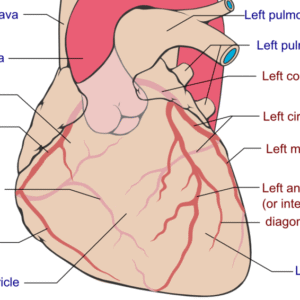Cardiology > Ebstein Anomaly
Ebstein Anomaly
Background
Ebstein anomaly is a rare congenital malformation of the tricuspid valve characterized by apical (downward) displacement of the septal and posterior tricuspid valve leaflets into the right ventricle. This creates “atrialization” of part of the right ventricle, leading to variable degrees of tricuspid regurgitation, right atrial enlargement, right heart failure, and arrhythmias. The severity of disease ranges from asymptomatic to life-threatening cyanosis and heart failure in neonates.
II) Classification/Types
By Severity:
- Mild: Minimal leaflet displacement and regurgitation; often asymptomatic
- Moderate: Noticeable tricuspid valve malformation with right heart enlargement
- Severe: Marked leaflet displacement, significant regurgitation, large atrialized right ventricle, and cyanosis
Carpentier Classification (based on valve morphology):
- Type A: Large functional right ventricle, minimal leaflet tethering
- Type B: Moderate leaflet tethering, smaller functional right ventricle
- Type C: Severe leaflet tethering with a small functional right ventricle
- Type D: Almost complete atrialization with a severely hypoplastic right ventricle
Pathophysiology
The downward displacement of the tricuspid valve leaflets results in part of the right ventricle functioning as part of the right atrium. This abnormality causes tricuspid regurgitation and right atrial dilation. The reduced right ventricular volume leads to decreased pulmonary blood flow and potential right-to-left shunting across an atrial septal defect or patent foramen ovale, causing cyanosis. The enlarged atrium predisposes to supraventricular arrhythmias, and in severe cases, right-sided heart failure and paradoxical emboli can occur.
Epidemiology
- Accounts for <1% of all congenital heart defects
- Incidence: ~1 per 200,000 live births
- Equal sex distribution
- ~50% of patients have an associated atrial septal defect or patent foramen ovale
- Associated with Wolff-Parkinson-White (WPW) syndrome in ~20% of cases
Etiology
I) Causes
- Congenital malformation during tricuspid valve development in embryogenesis
II) Risk Factors
- Maternal lithium use during the first trimester
- Genetic syndromes (e.g., ASD, WPW syndrome)
- Family history of congenital heart disease
Clinical Presentation
I) History (Symptoms)
- Neonates: Cyanosis, respiratory distress, signs of heart failure
- Children/Adolescents: Fatigue, palpitations, exertional dyspnea
- Adults: Atrial arrhythmias, right-sided heart failure, cyanosis
- Other: Stroke or TIA from paradoxical embolism
II) Physical Exam (Signs)
- Cyanosis and clubbing (if right-to-left shunt present)
- Prominent jugular venous pulsations
- Right ventricular heave
- Widely split first heart sound, loud P2
- Holosystolic murmur of tricuspid regurgitation at the lower left sternal border
- Gallop rhythm (S3/S4) in heart failure
Differential Diagnosis (DDx)
- Tricuspid valve dysplasia
- Atrial septal defect
- Tetralogy of Fallot
- Pulmonary atresia
- WPW syndrome
- Cor pulmonale
Diagnostic Tests
Initial Evaluation
- ECG: Right atrial enlargement, right bundle branch block, WPW pattern
- Chest X-ray: Cardiomegaly (massive right atrial enlargement), decreased pulmonary vascular markings
- Transthoracic echocardiography (TTE): First-line; assesses leaflet displacement and regurgitation
Advanced Imaging
- Transesophageal echocardiography (TEE): Better for evaluating associated defects and valve anatomy
- Cardiac MRI: Detailed anatomical evaluation, quantification of RV function
- Cardiac catheterization: For hemodynamic assessment; detects right-to-left shunting
Treatment
I) Acute Management
- Oxygen for cyanosis
- Diuretics for right-sided heart failure
- Antiarrhythmic therapy for supraventricular arrhythmias
- Anticoagulation for paradoxical embolism or atrial arrhythmias
II) Definitive Management
- Surgical Repair: Tricuspid valve repair (cone reconstruction) or replacement; ASD closure
- Palliative Procedures: Systemic-to-pulmonary shunt in neonates with inadequate pulmonary flow
- Heart Transplantation: In severe intractable cases
Medications
Drug Class | Examples | Notes |
Diuretics | Furosemide | For symptom relief in right-sided heart failure |
Beta-blockers | Metoprolol, Propranolol | Rate control in arrhythmias |
Antiarrhythmics | Amiodarone, Flecainide | For atrial or accessory pathway arrhythmias |
Anticoagulants | Warfarin, DOACs | For stroke prevention in AF or paradoxical embolism |
Pulmonary Vasodilators | Sildenafil, Bosentan | For associated pulmonary hypertension if present |
Device Therapy
- Pacemaker: For bradyarrhythmias or post-operative heart block
- ICD: If significant risk of sudden cardiac death or sustained VT
- Ablation: For WPW syndrome or supraventricular tachycardias
Patient Education, Screening, Vaccines
- Lifelong follow-up with adult congenital cardiology
- Education about cyanosis, arrhythmias, and stroke risk
- Endocarditis prophylaxis if prosthetic valve or residual shunts
- Routine vaccinations: Influenza, COVID-19, pneumococcus
- Reproductive counseling: Pregnancy risk assessment and MFM referral
Consults/Referrals
- Adult congenital cardiologist: Core for long-term management
- Electrophysiologist: For arrhythmias and WPW
- Cardiothoracic surgeon: For valve repair or replacement
- Neurology: If history of stroke or TIA
- Maternal-Fetal Medicine (MFM): In women with cyanosis or severe RV dysfunction
Follow-Up
Short-Term
- Postoperative monitoring of valve function and arrhythmia burden
- Echocardiography within 3–6 months after intervention
- Holter monitoring if arrhythmias are suspected
Long-Term
- Regular follow-up every 6–12 months
- Serial imaging (ECHO or MRI) to monitor RV size and function
- Ongoing assessment for arrhythmia development or progression
Prognosis
- Highly variable depending on severity at birth and timing of intervention
- Many adults with repaired or mild forms live normal lives with surveillance
- Risk of arrhythmias and right heart failure remains in long-term
- Neonatal presentation often carries a guarded prognosis without early surgery
- Timely surgical repair improves functional status and survival significantly
Stay on top of medicine. Get connected. Crush the boards.
HMD is a beacon of medical education, committed to forging a global network of physicians, medical students, and allied healthcare professionals.

